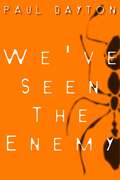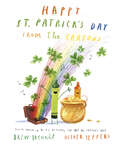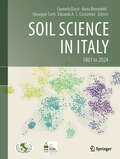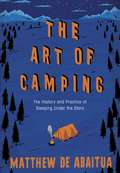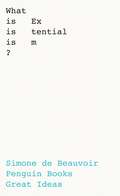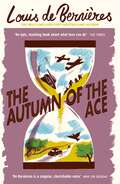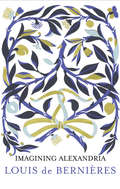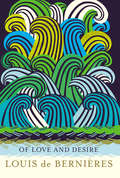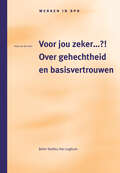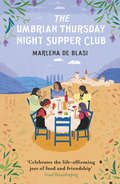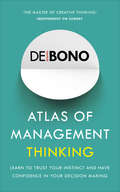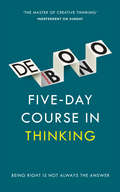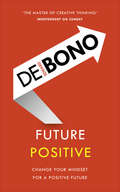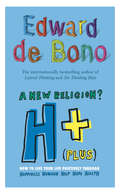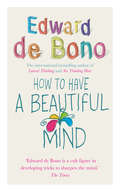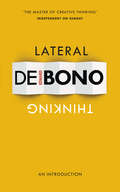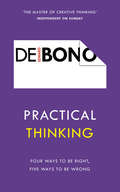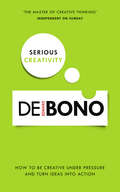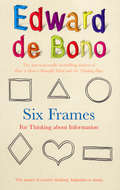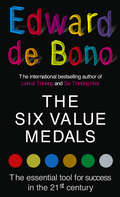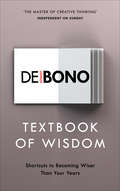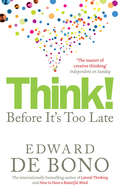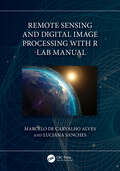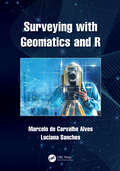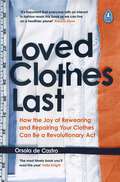- Table View
- List View
We've Seen the Enemy
by Paul DaytonAn alien ship crashes on Earth; its contents make it clear that the dead ant-like aliens inside were on an offensive mission. As humanity is presented with the prospect of their doomed world, construction begins on hundreds of World Federation ships and extrasolar defense weapons to be used in the inevitable war.We&’ve Seen The Enemy is set 700 years after the Great War and is a desperate race by a suicide team that may finally lead to the end of this interstellar war. Meanwhile, pockets of left-over human tribes on Earth have their own struggles, as they face power-hungry dictators and warped religious leaders. Behind all this are multiple alien forces, each with their own agenda. As truths turn into lies and friends become enemies, can humanity unite together to fight their common enemy?
Happy St. Patrick's Day from the Crayons
by Drew DaywaltThe hilarious crayons from the #1 New York Times bestselling The Day the Crayons Quit are ready to celebrate St. Patrick's Day! <p><p> St. Patrick's Day is almost here, and Green Crayon would like a break! (After all, he JUST had to carry a heavy load during Christmas...) His friends try to take over, but what's a leprechaun without green clothing? And a four-leaf clover can't be blue! And how in the world can the crayons make a rainbow without their good friend Green? <p><p>A humorous, small hardcover St. Patrick's Day story from everyone's favorite school supplies. <p> <b>New York Times Bestseller</b>
Soil Science in Italy: 1861 to 2024
by Carmelo Dazzi Anna Benedetti Giuseppe Corti Edoardo A.C. CostantiniHistory is generally defined as “the study of past events, particularly in human affairs” and is mostly understood when presented chronologically. That’s why someone also defined it as the ‘chronological record of the past’. Knowing the past is extremely important for any society and human being. Past gives us insights into our evolving behavior in many matters of life. The book is seen as a unique opportunity to preserve the memory of the Italian history of soil science. It represents a milestone and a cultural heritage. Moreover, the book is a sort of ideal bridge between the pioneers of soil science in Italy and the young generation of researchers, contributing to spreading awareness of the importance of soil as a fundamental resource.
The Art of Camping: The History and Practice of Sleeping Under the Stars
by Matthew De AbaituaCould there be another way of life? Can I survive with less stuff? Should I run for the hills?These are all good questions that people have asked before, throughout history, and which have inspired people to set up camp. But now camping is part of the drive for self-sufficiency, a reaction against mass tourism, a chance to connect with the land, to experience a community, to leave no trace . . . From packing to pitching, with hikes into the deep history of the subject and encounters with the great campers and camping movements of the past, this is the only book you'll need to pack when you next head off to sleep under the stars.IF THERE IS ONE THING THAT CAMPERS LIKE MORE THAN CAMPING, IT'S DREAMING ABOUT THEIR NEXT TRIP
What Is Existentialism? (Penguin Great Ideas)
by Simone de Beauvoir'It is possible for man to snatch the world from the darkness of absurdity'How should we think and act in the world? These writings on the human condition by one of the twentieth century's great philosophers explore the absurdity of our notions of good and evil, and show instead how we make our own destiny simply by being.One of twenty new books in the bestselling Penguin Great Ideas series. This new selection showcases a diverse list of thinkers who have helped shape our world today, from anarchists to stoics, feminists to prophets, satirists to Zen Buddhists.
The Autumn of the Ace
by Louis de Bernieres'De Bernieres is a singular, cherishable voice' Mail on SundayFrom the master of historical fiction, this book follows war hero Daniel Pitt and his unforgettable family after the Second World War.Some bonds are hard to break...Daniel Pitt was an RAF fighter in the First World War and an espionage agent for the SOE in the Second. Now the conflicts he faces are closer to home.Daniel's marriage has fractured beyond repair and Daniel's relationship with his son, Bertie, has been a failure since Bertie was a small boy.But after his brother Archie's death, Daniel is keen for new perspectives. He first travels to Peshawar to bury Archie in the place he loved best, and then finds himself in Canada, avoiding his family and friends back in England. Daniel and Bertie's different experiences of war, although devastating, also bring with them the opportunity for the two to reconnect.If only they can find a way to move on from the past...For more adventures with flying ace Daniel Pitt, see The Dust That Falls From Dreams and So Much Life Left Over.
Imagining Alexandria
by Louis de BernieresPoetry was Louis de Bernières’ first literary love and Imagining Alexandria is his debut poetry collection. Here the author of the much-loved Captain Corelli’s Mandolin returns us to the vivid Mediterranean landscape of his fiction.De Bernières was introduced to Greek poetry while in Corfu in 1983, and since then he has always travelled with a book of Cavafy's poetry in his pocket. Not surprisingly, his own poems about the distant past, the erotic and the philosophical owe much to the influence of the great Alexandrian poet.Beautifully illustrated with line drawings by Donald Sammut, this is a collection rich in sensuality, nostalgia, and music.
Of Love and Desire
by Louis de BernieresOf Love and Desire is a rich collection of love poems from Louis de Bernières, written over a lifetime, and capturing its many forms – from rapture, infatuation, urgency, to sorrow, heartache and disillusion. Poetry was de Bernières’ first and greatest literary love, a passion evident in the musicality and emotion of his poems, which are full of stories and the truth of lived experience. This, his second collection, bears the mark of many influences, from the classical Persian poets, to Neruda, to Quintus Smyrnaeus, to Brian Patten.Beautifully illustrated by Donald Sammut, this is an indispensable companion on the lover’s journey.
Voor jou zeker...?!.: Over gehechtheid en basisvertrouwen
by D. de Bie A.F. Bobbink Marijke van Bommel M.J. van Deutekom Mathieu Heemelaar M. Magnee A.J. RavelliWat is hechting? Waar komt het begrip ‘hechting’ vandaan en welke andere termen worden er gebruikt? Wat is een hechtingsprobleem en wat is een hechtingsstoornis? Wat is het gevolg van hechtingsproblemen en hoe moet je daar in de behandeling mee omgaan?Op al deze vragen gaat dit boek in. Niet uitputtend, maar voldoende om de lezer een beeld te geven van wat de achtergrond en de implicaties van een verstoorde hechtingsrelatie zijn.Het cahier Voor jou zeker…?! is bedoeld voor studenten en hulpverleners die zich willen verdiepen in de achtergronden en implicaties van een verstoorde hechtingsrelatie.
The Umbrian Thursday Night Supper Club
by Marlena de Blasi'If you loved Under the Tuscan Sun, you’ll love this' Red Magazine Every week on a Thursday evening, a group of four rural Italian women gather in an old stone house in the hills above Italy’s Orvieto. There – along with their friend, Marlena – they cook together, sit down to a beautiful supper, drink their beloved local wines, and talk. Surrounded by candle light, good food and friendship, the four women tell Marlena their evocative life stories, and of cherished ingredients and recipes whose secrets have been passed down through generations.
Atlas of Management Thinking
by Edward de BonoFirst published in 1981, this was the first book ever to be written explicitly for the right side of the reader’s brain. Much has been made of the research conducted into the left side of the brain – home to language and logic. The right side works in images, whole patterns and undefined feelings – none of which can be verbalized. This more elusive thinking often functions as what is loosely called ‘intuition’. In Atlas, de Bono shows us how to use the right side. It is an atlas because it is a visual reference of images and illustrations that point the reader in the right direction (literally). For anyone who has ever been told to trust their instinct, or who is concerned with management and decision-making, this book is a de Bono classic.
Five-Day Course in Thinking
by Edward de BonoFirst published in 1967, this remarkable title from one of history’s greatest minds remains a must-read in the world of creative thinking. Based on the tenet that an error can lead to the right decision, de Bono guides the reader through a series of non-mathematical problems and puzzles, all designed to help us analyse our personal style of thinking, work out its strengths and weaknesses, and to consider the potential methods that we never use.There are three courses, each five days long and each created to focus on a different style of thinking, featuring: The Bottles ProblemThe Blocks ProblemThe L-GameThe End GameA true life-changer, this book will have you thinking in ways that you never thought were possible.
Future Positive
by Edward de Bono‘Of one thing in life we can be sure. The quality of our life in the future will depend on the quality of our thinking.’Why are we so prone to be negative? And how can we become more positive, both as individuals and as a society? The answer lies in the way we think. The key to positive thinking is developing new concepts, whether this means coming up with a brand new idea or just looking at an existing one in a new light. If we make a deliberate and positive effort to change our thinking we can secure a positive future, and we can harness the focused power of human thinking by releasing it from its pettiness. Edward the Bono is the Nobel Prize nominated father of creative thinking and the master of training the mind to think the right way. He wrote the multi-million copy bestseller Six Thinking Hats and many other revolutionary works on how to think. This classic work was first published in 1979, and since then our belief in the power of positive thinking has only become stronger.
H+ (Plus) A New Religion?
by Edward de BonoH+ (Plus) A New Religion? provides a framework for achievement through daily acts of help or contribution. Whether this is offering other people something to laugh at or helping an elderly person cross the road, through these altruistic acts comes a sense of achievement, and from achievement comes self-esteem and a belief in oneself.Edward de Bono's new groundbreaking book offers an entirely positive way of life: with the emphasis not on sins that are to be avoided, but on things that are to be done. 'H' stands for:- Happiness- Help- Hope- Health - and, most importantly, Humour.
How To Have A Beautiful Mind
by Edward de BonoPeople spend a fortune on their bodies, their faces, their hair, their clothes. Cosmetics, plastic surgery, diets, gym membership - everyone's trying to be more attractive. But there's an easier way to become a beautiful person. It doesn't have to be physical. No matter how you look, if you have a mind that's fascinating, creative, exciting - if you're a good thinker - you can be beautiful.And being attractive doesn't necessarily come from being intelligent or highly-educated. It isn't about having a great personality. It's about using your imagination and expanding your creativity. And it's when talking with people that we make the greatest impact. A person may be physically beautiful, but when speaking to others a dull or ugly or uncreative mind will definitely turn them off.In clear, practical language, de Bono shows how by applying lateral and parallel thinking skills to your conversation you can improve your mind. By learning how to listen, make a point, and manoeuvre a discussion, you can become creative and more appealing - more beautiful.
Lateral Thinking: An Introduction
by Edward de BonoWhy do some people always seem to have new ideas while others of equal intelligence never do? Lateral Thinking is Edward de Bono’s original portrayal of what lateral thinking is, how it works and how to use it to develop your own potential for thinking and problem solving.First published in 1967 as The Use of Lateral Thinking, this classic international bestseller remains as relevant to learning, problem solving and creative thinking today as when it was first published. De Bono argues that conventional vertical thinking often inhibits our ability to solve problems and come up with new ideas. He then shows that lateral thinking is a far easier and more natural way to generate simple, sound and effective ideas and offers guidance on how to develop your own ability to think laterally. Lateral thinking is a technique that anyone can learn and benefit from.
Practical Thinking: Four Ways to be Right, Five Ways to be Wrong
by Edward de BonoIn Practical Thinking de Bono’s theme is everyday thinking, how the mind actually works – not how philosophers think it should. Based on the results of his famous Black Cylinder Experiment (a critical thinking task that asks participants why they think a black cylinder falls over), de Bono explores the four practical ways of being right. From there he picks out and names the five levels of understanding – and the five major mistakes in thinking. From memes and Instagram to twitter and bestselling books like Mistakes I Made At Work, mistakes – and what we can learn from them – are a hot topic. With Edward you’ll learn exactly why we all make them.
Serious Creativity: How to be creative under pressure and turn ideas into action
by Edward de BonoIf you want to be the best, focus on your most valuable asset: the power of your creative mindAs competition and the pace of change intensify, companies and individuals need to harness their creativity to stay ahead of the field. Under pressure, people often think they can't be creative; many more are convinced they are not creative at all because they have never been 'arty'. Creative genius Edward de Bono debunks these common notions in this remarkable book. He shows how creativity is a learnable skill - one that everyone can use to improve their performance. He then explains how you can unlock your own creativity to reap the personal and professional rewards it will bring. Learn how to:be creative on demand with de Bono's step-by-step approach add value to ideas and turn them into financial assets boost creativity with the power of lateral thinking break free from old ways of thinking with creative challenging
Six Frames: For Thinking About Information
by Edward de BonoAttention is a key part of thinking clearly and productively, and yet we pay very little attention to attention itself. If you see someone lying injured in the middle of the road, for example, your attention would go to that person but, if a bright pink dog wandered past at the same time, your attention would automatically stray to the dog. That is precisely the weakness of attention - it is pulled to the unusual. How much attention do we pay to the usual?So, what can we do about it? Instead of waiting for attention to be pulled towards something unusual, we can set out frameworks for 'directing' our attention in a conscious manner. Just as we can decide to look north, west or even south-east, so we can set up a framework for directing our attention, and that's where Edward de Bono's 'six frames' come in. Each frame is a direction or method in/with which to look, based on a different shape - triangle, circle, heart, square, diamond, slab.Today we are literally surrounded by information and it has never been so easy to obtain. Yet, information itself is not enough; it's how we look at it that really counts. Using the 'six frames' technique is the key to extracting real value from the masses of facts and figures out there and, like all de Bono's techniques, it is simple, effective and will utterly change the way you interpret information.
The Six Value Medals
by Edward de BonoTraditional thinking habits of businesses need to be greatly improved. Analysis and judgement are no longer enough to make important corporate decisions; you can analyse the past but you have to design the future. Corporate decisions depend on values. Disputes and conflicts often arise because of a clash of those values; each party in the dispute wants to pursue its own values, often at the expense of the other party. It is therefore essential that companies, managers and employees have a full understanding of the values of everyone involved to design a way forward that benefits all parties. From the bestselling author of How to Have a Beautiful Mind and Six Thinking Hats, this groundbreaking business book provides a basis for value assessment, an essential tool in decision-making for 21st century corporations. De Bono demonstrates that values come into all areas of thinking, behaviour and decision-making and outlines a framework to focus employees' attention on a variety of values including human values, organisational values, cultural values and perceptual values. By introducing a scoring system to rate different values as strong, sound, weak or remote de Bono helps readers to prioritise and make executive decisions that count.
Textbook of Wisdom: Shortcuts to Becoming Wiser Than Your Years
by Edward de BonoWisdom comes with living a long life, full of rich experiences and can’t be learnt, right? Wrong. In the Textbook of Wisdom bestselling author Edward De Bono (Lateral Thinking, Serious Creativity) explains how you do not have to have lived forever to benefit from the experience of those who have. Full of thinking tools guidelines and principles this ‘textbook’ encourages the use of values and emotions to guide you through life without allowing them to enslave you. Split into short, digestible sections perfect for grazing rather than devouring, Textbook of Wisdom is perfectly designed so you can return again and again, mining for wise words to carry through life that will open your mind to creativity and new possibilities.
Think!: Before It's Too Late
by Edward de BonoThe world is full of problems and conflicts. So why can we not solve them? According to Edward de Bono, world thinking cannot solve world problems because world thinking is itself the problem. And this is getting worse: we are so accustomed to readily available information online that we search immediately for the answers rather than thinking about them. Our minds function like trying to drive a car using only one wheel. There's nothing wrong with that one wheel - conventional thinking - but we could all get a lot further if we used all four... De Bono examines why we think the way we do from a historical perspective and uses some of his famous thinking techniques, such as lateral thinking, combined with new ideas to show us how to change the way we think. If we strengthen our ability and raise our thinking level, other areas of our life - both personal and business success - will improve.De Bono is the master of the original big 'concept' book and his enticement to us to use our minds as constructively as possible should appeal to a whole new generation of fans.
Remote Sensing and Digital Image Processing with R - Lab Manual
by Marcelo de Carvalho Alves Luciana SanchesThis Lab Manual is a companion to the textbook Remote Sensing and Digital Image Processing with R. It covers examples of natural resource data analysis applications including numerous, practical problem-solving exercises, and case studies that use the free and open-source platform R. The intuitive, structural workflow helps students better understand a scientific approach to each case study in the book and learn how to replicate, transplant, and expand the workflow for further exploration with new data, models, and areas of interest. Features Aims to expand theoretical approaches of remote sensing and digital image processing through multidisciplinary applications using R and R packages. Engages students in learning theory through hands-on real-life projects. All chapters are structured with solved exercises and homework and encourage readers to understand the potential and the limitations of the environments. Covers data analysis in the free and open-source R platform, which makes remote sensing accessible to anyone with a computer. Explores current trends and developments in remote sensing in homework assignments with data to further explore the use of free multispectral remote sensing data, including very high spatial resolution information. Undergraduate- and graduate-level students will benefit from the exercises in this Lab Manual, because they are applicable to a variety of subjects including environmental science, agriculture engineering, as well as natural and social sciences. Students will gain a deeper understanding and first-hand experience with remote sensing and digital processing, with a learn-by-doing methodology using applicable examples in natural resources.
Surveying with Geomatics and R
by Marcelo de Carvalho Alves Luciana SanchesSurveying with Geomatics and RThis book explains basic concepts of surveying science and techniques with geomatics using R software and R packages. It engages students in learning about surveying through real field examples and using differing degrees of complexity while exploring surveying problems based on field observations and advanced geospatial technology. It includes a wide range of case studies as hands-on and self-paced tutorials along with detailed computer programming routines that are linked to the theories and applications explained in each chapter. This innovative textbook also teaches how to explore other possibilities of using geomatics in geocomputation, remote sensing, geography and cartography courses focused on surveying tasks.Features include: Provides modern surveying practices with free software algorithm and R toolset for active learning Includes case studies from different geographical areas using arbitrary and international cartographic reference systems Enables and demonstrates the integration of traditional geomatics with modern geospatial big data technologies Explains data standards, equipment used, possible analyses and the importance of error evaluation for scientific surveying Discusses different scales of landscapes and brings together the experiences of leading experts in the field
Loved Clothes Last: How the Joy of Rewearing and Repairing Your Clothes Can Be a Revolutionary Act
by Orsola de Castro'It's important that everyone with an interest in fashion reads this book so we can live on a healthier planet' Arizona Muse 'The most timely book you'll read this year' India Knight* * * * * Running out of space for the clothes you can't stop buying? Curious about how you can make a difference to the environmental challenges our planet faces? Join Orsola's care revolution and learn to make the clothes you love, last longer.This book will equip you with a myriad of ways to mend, rewear and breathe new life into your wardrobe to achieve a more sustainable lifestyle. By teaching you to scrutinise your shopping habits and make sustainable purchases, she will inspire you to buy better, care more and reduce your carbon footprint by simply making your loved clothes last longer.Following Orsola's practical tips to lavish care and attention on the clothes you already own will not only have a positive environmental impact, but will be personally rewarding too: hand wash, steam and spot clean your clothes, air dry instead of tumble drying, or revive your clothes by sewing or crocheting.Fast fashion leaves behind a trail of human and environmental exploitation. Our wardrobes don't have to be the finish line; they can be a starting point. We can all care, repair and rewear. Do you accept the challenge?* * * * *'An incredibly thoughtful, must-read guide' Kenya Hunt'A must read for anyone who wants to understand the fashion industry as an outsider and wants direction as to where we go next' Aja Barber
